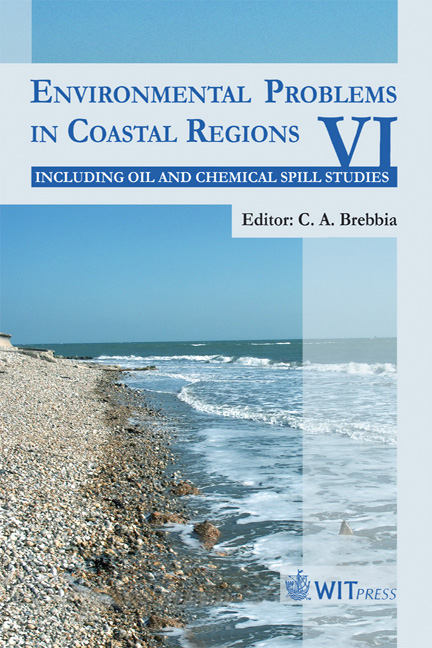Assessment Of Escherichia Coli Viability In Coastal Sicilian Waters By Fluorescent Antibody And β-glucuronidase Activity Methods
Price
Free (open access)
Transaction
Volume
88
Pages
10
Published
2006
Size
487 kb
Paper DOI
10.2495/CENV060061
Copyright
WIT Press
Author(s)
G. Caruso, G. Zappalà, R. Caruso & E. Crisafi
Abstract
Monitoring the viability of pathogens in bathing waters is crucial for public health preservation. The fluorescent antibody (FA)-viability method, using antibodies for Escherichia coli combined with CTC (5-cyano-2, 3 ditolyl tetrazolium chloride, marker of active respiring cells) or PI (propidium iodide, marker of membrane-damaged cells), and the β-glucuronidase activity test (by 4- methylumbelliferyl-b-d-glucuronide, MUG) offer interesting perspectives for detecting this bacterial indicator of faecal pollution. The viability of E. coli cells in Sicilian seawaters was evaluated on a seasonal scale (n = 89 samples) by FA and MUG compared to the standard culture method (by m-FC agar). The total microscopic counts obtained exceeded the culturable counts (m-FC) by one order of magnitude; actively respiring (CTC+) cells accounted, on average, for 63% of the total E. coli population. β-glucuronidase activity rates ranged from 0.00004 to 726.88 nmol MUF 100 ml-1h-1, and were particularly enhanced during autumn and spring. The percentage of membrane-damaged cells increased in summer and in winter, probably due to adverse environmental conditions. In winter, high numbers of culturable cells suggested continental run-off to be an important source of pathogens; bacterial cells, however, were not actively respiring, but were membrane-damaged or with low metabolism, as indicated by the increase in PI counts and the decrease in MUG rates, respectively. In spring, increased numbers of CTC (+) cells and β-glucuronidase rates suggested the recovery of some metabolic functions. Both methods used provided evidence that some viability properties were retained by E. coli cells after their discharge into seawater; therefore their combination could be proposed as a useful and rapid tool for environmental monitoring. Keywords: Escherichia coli, marine waters, FA-viability, MUG.
Keywords
Escherichia coli, marine waters, FA-viability, MUG.





